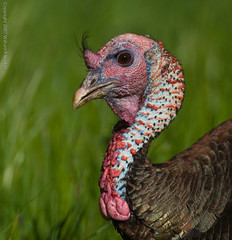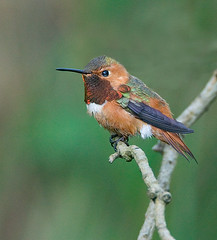This morning I went to Rancho San Antonio in search of owls, woodpeckers, and passerines, but I found these Wild Turkeys instead. They seemed to like the shadows, but by sitting patiently I got a few shots of them out in the morning sun, where their wild colors and crazy features were fully illuminated.
More photos at flickr.
Thursday, March 22, 2007
Bill's photography workflow
Here's an overview of my current photography workflow. I wrote it up as part of my evaluation of iView, Aperture, and Lightroom. To really understand what I like and don't like about those three applications, you have to understand a bit about how I use iView right now.
(0) SHOOTING: I shoot a Canon 20D in raw mode, then insert each CF card into a Firewire CF reader attached to my MacBook Pro and do the following steps:
(1) DOWNLOADING: I use an AppleScript I wrote called "BillDownloaderPro" that automatically (a) opens a Mac OS X Saved Search for all the RAW files on the CF card, (b) creates a "photos-200N-NN-NN" folder in my laptop photo Backups folder. I drag the images from the Saved Search into the new folder and wait while they copy (this last step should also be automated, but I can't figure out how to select all the Saved Search items from AppleScript).
(2) TAGGING: I then launch Adobe Photoshop Bridge and use it to edit the contents of the newly created folder. I use a Bridge metadata template to set my copyright information on all the images. I set the Location, City, State, and Country fields in the IPTC. I set a basic keyword on each image to distinguish Landscapes from People from Birds.
(2A) QUICK DEVELOP: Sometimes while doing this initial tagging in Bridge I will open a few images in Adobe Camera Raw (ACR) and do a quick crop + white balance + tone edit, usually followed by opening a few images in Photoshop and running an Photoshop Action that prepares them as JPEG's for uploading to flickr.
(2B) QUICK DELETE: Sometimes while doing this initial tagging in Bridge I delete obviously bogus photos with problems like subject out of focus, exposure wildly wrong, flash didn't fire, wrong bird head angle.
(3) CATALOGING: I quit Bridge and import the folder of tagged raw files into my main iView MediaPro catalog. This main catalog contains information about all 30,000 images in my library. Once iView is finished making thumbnails for the new images, I start assigning ratings, deleting more bogus pictures, building collections of images I might use for printing wall calendars, and adding photos to birdWalker, my official blog and database for tracking our birding lifelist and my bird species photographed lifelist.
(4) LIBRARY MANAGEMENT: I store the primary copy of the library on three external Firewire harddisks, mostly laptop-sized for easy use on the train and while travelling. In addition to the primary catalog, I have two backup copies. One backup copy is stored on a 300GB external harddisk, a second backup copy on my 750GB RAID server at home. Hopefully within a few days of downloading a day's images I have copied them onto the appropriate primary library external disk and backup disks, at which point I prefix an "ok-" to the name of the copy of the folder on the laptop's internal disk, signifying that it can be deleted as necessary. Every several months I shift over several months of photos from the most recent primary library harddisk to the next most recent disk.
(5) MAINTENANCE/ONGOING: Over time I will revisit various images in the library. I use iView saved metadata searches to locate images with new keywords, bird images with no locations, and bird images with no SpeciesCommonName to make sure I've finished my cataloging. I revisit a day's shooting from several weeks ago and weed out further images. I rediscover good images, open them in Photoshop, and post them to flickr.
(0) SHOOTING: I shoot a Canon 20D in raw mode, then insert each CF card into a Firewire CF reader attached to my MacBook Pro and do the following steps:
(1) DOWNLOADING: I use an AppleScript I wrote called "BillDownloaderPro" that automatically (a) opens a Mac OS X Saved Search for all the RAW files on the CF card, (b) creates a "photos-200N-NN-NN" folder in my laptop photo Backups folder. I drag the images from the Saved Search into the new folder and wait while they copy (this last step should also be automated, but I can't figure out how to select all the Saved Search items from AppleScript).
(2) TAGGING: I then launch Adobe Photoshop Bridge and use it to edit the contents of the newly created folder. I use a Bridge metadata template to set my copyright information on all the images. I set the Location, City, State, and Country fields in the IPTC. I set a basic keyword on each image to distinguish Landscapes from People from Birds.
(2A) QUICK DEVELOP: Sometimes while doing this initial tagging in Bridge I will open a few images in Adobe Camera Raw (ACR) and do a quick crop + white balance + tone edit, usually followed by opening a few images in Photoshop and running an Photoshop Action that prepares them as JPEG's for uploading to flickr.
(2B) QUICK DELETE: Sometimes while doing this initial tagging in Bridge I delete obviously bogus photos with problems like subject out of focus, exposure wildly wrong, flash didn't fire, wrong bird head angle.
(3) CATALOGING: I quit Bridge and import the folder of tagged raw files into my main iView MediaPro catalog. This main catalog contains information about all 30,000 images in my library. Once iView is finished making thumbnails for the new images, I start assigning ratings, deleting more bogus pictures, building collections of images I might use for printing wall calendars, and adding photos to birdWalker, my official blog and database for tracking our birding lifelist and my bird species photographed lifelist.
(4) LIBRARY MANAGEMENT: I store the primary copy of the library on three external Firewire harddisks, mostly laptop-sized for easy use on the train and while travelling. In addition to the primary catalog, I have two backup copies. One backup copy is stored on a 300GB external harddisk, a second backup copy on my 750GB RAID server at home. Hopefully within a few days of downloading a day's images I have copied them onto the appropriate primary library external disk and backup disks, at which point I prefix an "ok-" to the name of the copy of the folder on the laptop's internal disk, signifying that it can be deleted as necessary. Every several months I shift over several months of photos from the most recent primary library harddisk to the next most recent disk.
(5) MAINTENANCE/ONGOING: Over time I will revisit various images in the library. I use iView saved metadata searches to locate images with new keywords, bird images with no locations, and bird images with no SpeciesCommonName to make sure I've finished my cataloging. I revisit a day's shooting from several weeks ago and weed out further images. I rediscover good images, open them in Photoshop, and post them to flickr.
Thursday, March 15, 2007
Hummingbird Quest
Hi, just a quick note to thank Gary Aspenall for his detailed directions to El Polin Loop, a location where he has previously photographed Allen's Hummingbird. This quiet natural spring in the middle of the Presidio turned out to be very productive, with the hummers posing on useful perches and drinking from the spring in close proximity. There's not a lto of light, but even so I highly recommend it as a place for practicing your hummingbird shot. Bring warm clothes for the first hour of daylight, and stay alert -- these little guys move fast!
Subscribe to:
Comments (Atom)


